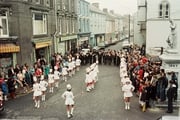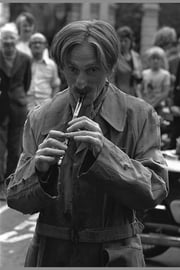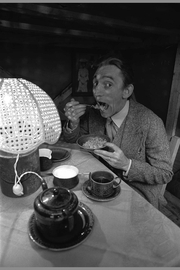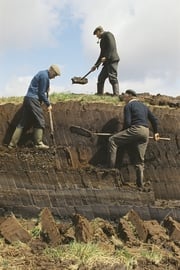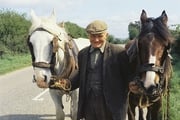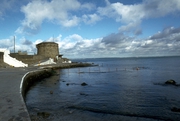Country Brass – Cork Butter Exchange Band, RTÉ One, Monday 2 January, 7.30pm
The Cork Butter Exchange Band was a feature of Cork street life since 1837. Founded as part of the Temperance Movement, it roamed the gas lit narrow lanes of Cork during Famine Times and was an important feature of Cork city life throughout the 70s.
This archive programme was first broadcast in 1979 as part of a series on Irish brass and reed bands. Producer Peter McEvoy was inspired by a Frank O Connor short story about a Cork brass band called ‘Sons of Orpheus’. He realised how so much of life is in a brass band. All of town life is represented there. So he created a 6 part series which paints a portrait of 70s town life in Limerick, Galway, Drogheda, Mullingar, Skibbereen and Cork.
The programme goes behind the scenes in rehearsal, on tour and in the working life of some of the band members. See bikini clad girls playing a local version of ‘It’s A Knock Out’ by the banks of the Lee. Follow the band as it travels by bus to perform for the Bishopstown Community Association summer fete. Meet band members at work in Verolme Shipyard. And see the members demonstrating their musical versatility playing in a local show band.
Membership of the band was considered very special, both to its members and to fellow Corkmen. It was not easy to gain membership. One member describes how he had been interviewed for admission in 1922. ‘It was not easy to get in at that time. It was not everyone they would take. You had to go up before the committee and they looked into your background…your family’ . Membership at the time brought a status that caused fellow Corkonians to nudge one another to be careful how they spoke in front of ’a Buttera man’.
Set up as an all male band, it was in the 70s that women first began to gain membership. In this programme we see only one skirt-the red skirt of a pioneering flautist.
As Donncha O Dulaing’s lyrical script makes clear, the Cork Butter Exchange Band was the personification of South Side Cork and was distinctly different from the Northside Cork Barrack Street band. The bands are now merged and it is the Cork Barrack Street band that endures.
Rural Portrait – King Of The Road, RTÉ One, Monday 2 January, 8.30pm
First broadcast in 1968, this is a simple profile of a quiet, contented man. Michael Cleary and his father, between them spanned over ninety years working the roads of South Tipperary.
He lives with his wife and 4 children in a County Council house in the picturesque countryside near Cahir. His life is frugal and the family have a pony and trap to get them into Cahir for the carefully planned weekly shopping. Michael’s job is to fill in the potholes with his barrel of stones and his shovel and spade and to trim the hedges and top the stone walls of the county.
There are over 1,500 miles of roads in County Tipperary, so Michael is never short of work. Most of his work is by hand, bucket and tar brush in hand, but there is some machinery in evidence. And it this machinery that will likely replace him when he retires, predicts reporter Brian Cleeve.
The programme series was devised by Odran Walsh and aimed to portray the lives of ordinary country people. It was not intended as analytical, but as a reflection on a way of life.
The series consists of three men, a road worker, a vicar and a factory worker. No women.
The wives are interviewed and filmed about their daily domestic lives but the programme is of a piece with attitudes of the time. In fact reporter, Brian Cleeve’s commentary editorialises about Michael Cleary’s life in a somewhat patronising fashion peculiar to the time. He expresses regret that Michael Cleary is content with so little. ‘Discontent drives civilisation’, he says.
So the contentment of this man and his family for the lovely home, happy family life, job security all set amidst the lush Tipperary landscape where Michael shoots game in the long summer evenings, is a lifestyle that Brian Cleeve considers limited and worthy of discontent.
The programme shows us a different Ireland, a poorer and more contented place.
Terminus: Gola Island, RTÉ One, Tuesday 3 January, 23.45pm
Gola Island is the magic island of the song, familiar to all Irish schoolchildren, Báidín Fheilími. It’s a place of majestic sea cliffs, rocky coastlines and crashing Atlantic swells. A place of endless skyline and lonely beauty. This film is an elegy to this magic island and an epitaph to its death.
Terminus: Gola Island, is a creative documentary and does not seek to analyse or inform, but to inspire a sense of loss. Odran Walsh, RTE film maker, describes his film in these words:
‘Far out on the sun-set edge of Europe, a fragment of Ireland dies. For three hundred years Gola was well populated, but within the last decade, its life has ebbed away into silence….Echoes and ghosts inhabit the island now-the lives and loves, the sorrows and joys of ten departed generations. This film is a tribute, and an epitaph to the hardy people who battled the elements here for three weary generations.’
Gola Island is situated off the coast of Donegal. The nearest harbour is Bunbeg and the nearest town is Gweedore. According to records, its population at the beginning of the 19th century was 300. It once formed part of the estate of Gweedore and was owned by Lord George Hill, of Hillsborough Castle who married Cassandra and Louisa Austen Knight, nieces of the English novelist, Jane Austen. After the Famine, the numbers gradually dwindled and this film captures the poignancy of the departure of the final 6 inhabitants as they leave with their few belonging for a life on the mainland.
RTÉ commissioned a social survey of Gola Island from F.H.Aalen, of the TCD geography department. The survey tells of a dwindling community, the effect of the slow drip of emigration, the sense of isolation and a feeling of ‘missing out’ by its inhabitants on the perceived delights of urban living. The programme was intended to spark a debate about the fate of west of Ireland sea coast communities who were haemorrhaging emigrants to the cites and to America throughout the 60s.
‘You may not like Gola Island, in the sense of being entertained or reassured. It’s a sombre programme-……even a desolate and depressing one. But it had to be made, because we can’t always look the other way while our island communities give up and die’. Odran Walsh RTE Guide 1970.
OILEÁN: Anam Chloch, RTÉ One, ,Tuesday 3 January, 12.15am
Anam Cloch, broadcast in 2008 as part of the Oileán series brings us up to date with Gola Island which is now attracting new residents who have set out to reclaim this magic island, the subject of the famous song, Báidín Fheilimí. They include an adventurer and mountaineer, a former member of Daniel O’Donnell’s band and a woman who plans to restore the crumbling school house.
Deintear athghabháil ar an oileán a bhfuil cáil air san amhrán ‘Báidín Fheilimí’ – athghabháil ar son an phobail, sa cheathrú chlár den tsraith ‘OILEÁN’. Sé Gabhla an oilean céanna, amach ó chósta Dhún na nGall. Mealltar dreapadóir sliabh, ar thaistealaí domhanda chomh maith é, ar ais go Gabhla. É féin agus daoine eile leis – ina measc, iar-cheoltóir le banna Daniel O’Donnell, siopadóir ar bhádóir farrantóireachta leis é, agus bean óg chróga a bhfuil oll-dhearadh álainn ina ceann aici do sheanscoil thréigthe an oileáin.
Insítear na scéalta seo uilig istigh ar an oileán – ceann de na seoda faoi rún i measc na n-oileán álainn thart fá chósta na hÉireann.
Self Portrait – Sylvia Beach, RTÉ One, Thursday 5 January, 11.45pm
This RTÉ Archive gem features an interview with Sylvia Beach, the extraordinary woman who published James Joyce ‘Ulysses’ and founded the famous Paris bookshop ‘Shakespeare and Company.
It was Sylvia Beach who first agreed to publish Joyce’s ‘Ulysses’.1920s Europe was a period of extreme literary censorship, when the English-speaking world refused to print what they saw as pornographic filth. She tried to persuade Joyce to wait for the backing of a large publishing house, but he refused. He trusted her and believed his book so extraordinary that it did not need a big publishing house to become famous. Her boldness paid off, as ‘Ulysses’ became an overnight sensation.
Born to a privileged background in New Jersey, USA, she made her life in Paris where she set up the legendary Parisian book shop, Shakespeare and Company Throughout the 1920s, Paris literati frequented her shop: George Bernard Shaw, Ezra Pound, Gertrude Stein, Paul Valèry, André Gide and of course James Joyce.
In 1962, Syliva beach was invited to come to Dublin to open the James Joyce Tower. In this ‘Self Portrait’, she tells RTE interviewer Niall Sheridan how, in 1941, Paris was under Nazi occupation and most writers had either been conscripted or had fled. Beach kept plying her book trade until one morning a Nazi officer came in to buy her last copy of ‘Finnegan’s Wake’.. She refused to sell it, and he ordered that the shop be closed down. That very same day, Sylvia Beach with the help of friends, removed all books from the store and painted over the sign of Shakespeare and Company. When the Nazi returned with reinforcements to close the store down, two hours later, there was no evidence that the shop had ever existed.
She describes in lively fashion the excitement of the liberation of Paris. Ernest Hemingway arrived bloodied but triumphant. When Sylvia invited him for a celebratory drink, he said ‘No thanks, I’m off to liberate the Ritz Hotel wine cellar’
Sylvia beach died in 1962 shortly after this interview
This RTÉ Archive gem from 1962 has been re-mastered especially for the Bloomsday centenary and provides a rich context for the original publication of Ulysses.
John Molloy’s Dublin, RTÉ One, Thursday 5 January, 8.30pm
This unique programme, especially restored for TV50, and first broadcast in July 1976, features Dublin actor and revue artist John Molloy. The programme is a combination of comedy sketch and mime and re-enacts the lives and characters of Dublin ‘in the rare auld times’.
John Molloy was a Dublin born actor and a contemporary of Brendan Behan, Patrick Kavanagh and J.P. Dunleavy. He was part of Dublin’s literary set who frequented the snugs and pubs of inner city Dublin and shared the literary gossip of the day. He starred in films with Barry Fitzgerald and was in the first series of RTÉ’s Tolka Row.
His style was unique for the time. He studied mime in Paris under Marcel Marceau. He wrote more than 40 revues and one man shows where he brought to life the street characters and working life of the Dublin of his day.
This programme is without script and films his fictitious characters as they wander through John Molloy’s version of Dublin. He happens upon The Bothy Band and Horslips and the programme features performances by both bands then at the height of their popularity.
John Molloy worked and lived in San Francisco towards the end of his life and died there in 1999
Scope – The Four Roads, RTÉ One, Friday 6 January, 7.30pm
This 1973 Pat O Connor film follows the daily life of 70-year-old Winnie Mongan as her family wend their way around the highways and byways of Ireland on their annual pilgrimage to the Ballinasloe Horse Fair. Every year, the Mangans and other traveller families congregate at the fair to play music, meet old friends and trade horses.
En route, we hear of the life of hardship of the travellers. They live in small, wooden, horse drawn caravans. The women have many children born on the roadside whom they have to rear in the most primitive circumstances. We see their struggles to wash children and clothes on the leafy roadside.
Winnie describes the cold and fear attached to giving birth alone on the roadside and the struggle for survival which was her early life
Their consolation is music. At evenings they build a fire and smoke and sing, tell stories and play the fiddle. The light from the fire casts shadows on the careworn faces and the deep lines in Winnie Mongan’s face tell their own story.
The film is shot with elegance and style and the night time scenes are truly memorable. Pat O Connor interviews are unobtrusive and the Mongan’s provide the commentary so their story comes directly to the viewer.
Wheels of the World – Life in North Kerry, RTÉ One, Friday 6 January, 8.30pm
This beautiful film by Pat O Connor is based on an idea by Con Houlihan, Kerry raconteur and sportswriter. Shot over 10 days in May 1974, it sets out to capture the sounds and rhythms of rural life. Houlihan’s script conveys a melancholy view of Kerry life:
‘Imagination was not given to us to make the worst of a good world but to make the best of a middling job’ is typical of the tone of the piece. But the scenes will surprise you. Fishermen mending nets, men cutting turf, man and donkey working in harness, many scenes are evocative of a pre-war Ireland. This is certainly an Ireland untouched by the swinging 60s.
Saturday night in the pub provides the opportunity for some lively dancing and intense debate. The dancing is Irish dancing and is undertaken with serious intent by some primly-dressed ladies. Here and there one sees long-haired youth dressed in cool 70s gear. But they stay in the background. This is not a film which focuses on the future and the young.
Sunday shows the community congregating around the church. Bishop Eamon Casey makes a jovial appearance. Mass attendance is universal, but are the men ‘catching mass’ outside the church because they can’t get a seat inside or because they are seeking some kind of sense of distance between themselves and the church?
This is not a film which asks questions. It does not provide solutions or analysis. Instead it offers a poetic view of what was a fading Ireland. But one with a stateliness and dignity which may even seem enviable to the modern viewer. ‘The country grows into the image of the people. To the soul’s geography each becomes a symbol of the other’. If Con Houlihan’s words have any validity, how would they apply today?
